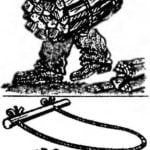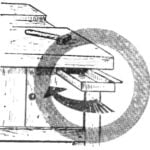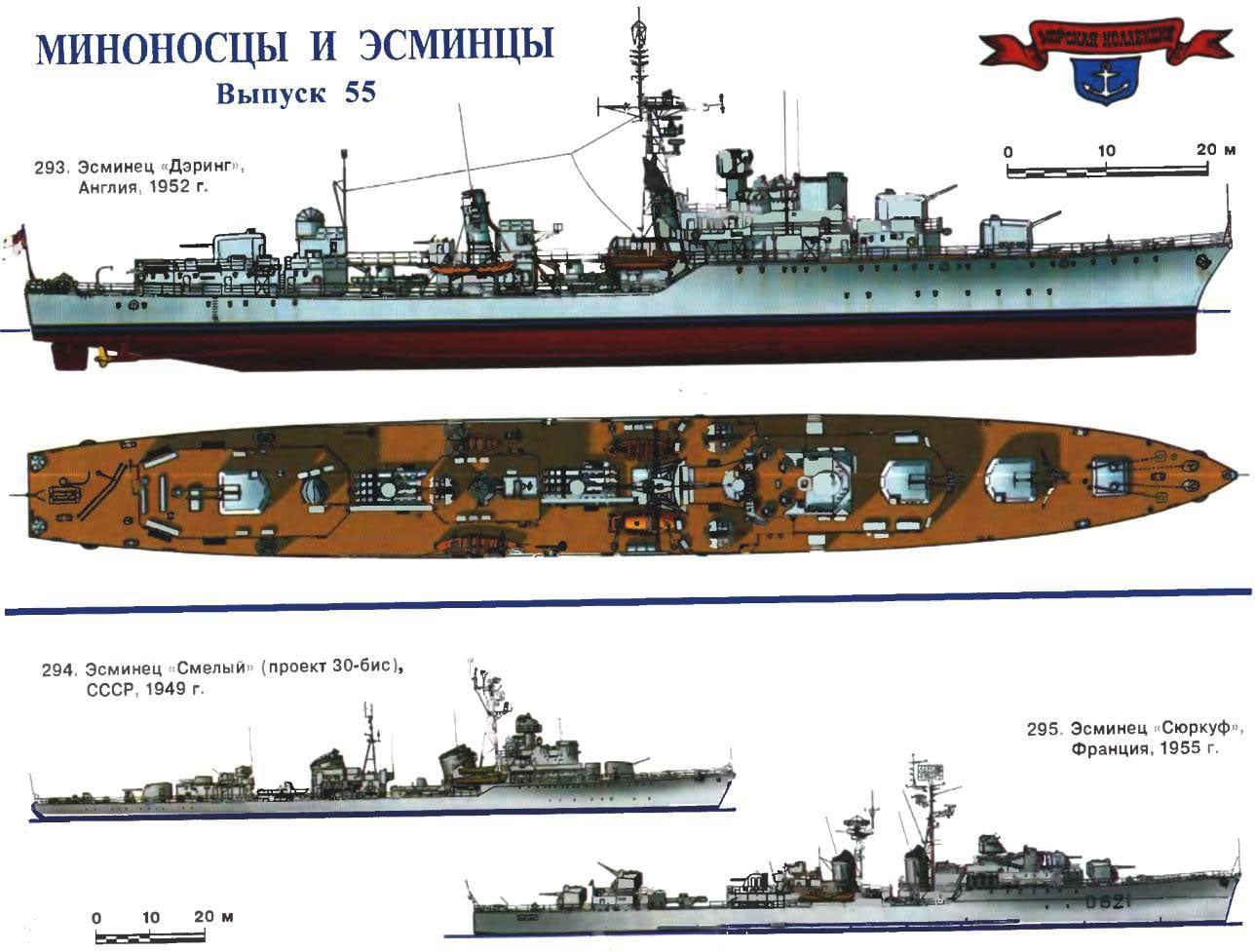 The end of the Second world war and the beginning of the war “cold” put shipbuilders leading countries of the world in a very difficult situation. What will be the fleet of the near future? A plausible answer to this question. On the one hand, the naval theorists and engineers have gained an extensive experience of fighting the sea, which, it would seem that rightly could be considered the criterion of truth. On the other hand, progress in military technology has been so rapid that to follow him is not always possible. Electronics, jet aircraft, guided missiles, nuclear weapons—all these innovations have required reflection, and the most reasonable solution here would be not to rush and to “pause”. However, to do so would have taken the United States by the end of 1945 they had a huge fleet and was considered to be the undisputed world leader. Other countries, especially those whose Navy suffered heavy losses, could not wait and started to build new ships immediately. The result of this venture was quite natural: the first post-war destroyers, developed on the basis of previous projects, at the time of entry into service turned out to be obsolete and unfit for combat missions in a new environment.
The end of the Second world war and the beginning of the war “cold” put shipbuilders leading countries of the world in a very difficult situation. What will be the fleet of the near future? A plausible answer to this question. On the one hand, the naval theorists and engineers have gained an extensive experience of fighting the sea, which, it would seem that rightly could be considered the criterion of truth. On the other hand, progress in military technology has been so rapid that to follow him is not always possible. Electronics, jet aircraft, guided missiles, nuclear weapons—all these innovations have required reflection, and the most reasonable solution here would be not to rush and to “pause”. However, to do so would have taken the United States by the end of 1945 they had a huge fleet and was considered to be the undisputed world leader. Other countries, especially those whose Navy suffered heavy losses, could not wait and started to build new ships immediately. The result of this venture was quite natural: the first post-war destroyers, developed on the basis of previous projects, at the time of entry into service turned out to be obsolete and unfit for combat missions in a new environment.
For the restoration of the fleet came from the Soviet Union. In October 1945 the Council of people’s Commissars approved a 10-year shipbuilding program, which was planned to build over three thousand combat ships and boats, including the 34 cruisers, 188 destroyers and 367 submarines. And in the interest of saving time, decided to maximize the finished projects with minimal rework. In particular, the serial construction of destroyers proposed to expand the drawing “Fire” (see “modelist-Konstruktor” No. 11, 2001). The fact that the vehicle does not quite meet the requirements yet at the time of project approval (1939!), somehow no one is confused.
Head destroyer project 30 bis “Bold” was commissioned by the Soviet Navy on the 70th anniversary of I. V. Stalin in December 1949. The architecture and layout he kept repeating “Fire”, differing only slightly increased dimensions and a slightly enhanced anti-aircraft armament. Torpedo steel petitionee (however, the specifications they were supposed to be on “tridtsatka” — they simply do not have time to produce). The increase in the displacement went mainly to strengthen the hull structure and increased fuel capacity. Great attention was paid to the improvement of the efficiency of buildings, in particular, the monocoque shell provides for the possibility of sectional Assembly. The latter played an important role: a large series of ships (70 units) managed to build in just five years. And in the construction of one of the ships — “Able”—was set unbeaten record, from laying the destroyer before the signing of the acceptance certificate in less than ten months — the case for the domestic industry is unique.
“Thirty-bis” with the cruisers of the “Sverdlov” became a sort of “calling card” of the Soviet Navy 50 years — mainly due to the elegant “minekonom” silhouette. However, besides the spectacular appearance, the other advantages of these ships was questionable. The destroyers had bad seaworthiness, the lack of cruising range, old-fashioned energy, weak detection, inefficient anti-aircraft and anti-submarine weapons… In General they conformed to the standards 30 years too late to be born fifteen years! Ships of the project 30-bis was the only one in the world of post-war built destroyers with artillery is not universal. Alas, but the construction of the largest in the history of our Navy series of destroyers was also the most ill-conceived waste of money.
UK by the end of the Second world war, moral was not yet ready to say goodbye to the title “mistress of the seas” and therefore to abandon the construction of new vessels is not desired. As we already know, the Royal Navy began to be equipped with more modern destroyers of the type “battle” (see “Mode-list-constructor” No. 8 of 2001) only to 1945. And most of the “battlow” to the end of hostilities was still under construction. Also on the stocks were the ships of the “Battlex” (series “Wepon”— “Weapons”). The latter was smaller in size, carrying humble weapons from twin 102-mm anti-aircraft guns in deck outdoor installations, but had increased viability of the power plant by exploding boilers and engine rooms. Externally, “Battlex” stand out for their unusual silhouette for the first time after the famous “triplow” the British destroyer was a twin, but the thin nasal tube was hidden inside the lattice mast.

293. Destroyer “Daring”, England, 1952
Were built by “Swan hunter”. Displacement standard, t 2830, full 3580 T. maximum Length 118,8 m, beam of 13.1 m, draught 4,1 m. Capacity twin-shaft turbine installations 54 000 HP, speed 34.7 per node. Armament: six 114-mm universal guns, six 40-mm guns, two platetronic 533-mm torpedo tubes. Total built 11 units: eight in 1952-1954 years in England and three in 1957— 1958 in Australia. One of the British ships in 1964 sold to Australia and the other two are Peru in 1970.
294. The destroyer “Courageous” (project 30-6ис), USSR, 1949
It was built at the plant named after A. A. Zhdanov in Leningrad. The standard displacement of 2316 tons full 3066 t maximum Length of 120.5 m, width 12 m, draft 3,9 m. Capacity twin-shaft turbine installation 60 000 HP, speed 36.5 per node. Armament: four 130-mm guns, two 85-mm anti-aircraft guns, seven 37-mm guns, two platetronic 533-mm torpedo tubes. Only in the years 1949-1953 built 70 units. Later 16 ships transferred to other countries (two to Poland, six to eight Egypt and Indonesia).
295. Destroyer “Surcouf”, France, 1955
Built at the shipyard in Lorient. The standard displacement of 2750 tons, full 3740 t maximum Length of 128.6 meters, width 12,7 m, draft 5,4 m. Capacity twin-shaft turbine installations 63 000 HP, speed 34 knots. Armament: six 127 mm universal guns, six 57-mm and four 20-mm machine gun, four three-pipe 550-mm torpedo tubes. Only in the years 1955-1957 built 12 units.
At that time, the Admiralty already had developed plans for a new destroyer, which was finally deprived of the obvious shortcomings of their predecessors. The project was approved in February 1945 until the end of the war had to give the order for building 16 ships. However, head “, During” laid down in September 1945. The ensuing economic crisis forced a review of the shipbuilding program in the direction of their sharp contraction, but a series of new destroyers managed to defend, although shortened to eight units.
“Daring” was a long “battle” with the third 114-mm turret and architecture something like “Wepon”. It was a pretty big ship: the state of his crew, corresponds to the rank of the cruiser with the captain (captain 1st rank) at the head. Housing first for the British shipbuilding-welded was performed (which, incidentally, caused a lot of technological problems). Steam turbine had a higher steam parameters and have good survivability due to a better layout. Thanks to new boilers and improved gear the prefix “Daring” 590 tonnes of oil could pass the 20-node swing 4440 miles, while smaller in size, “Battle” for this purpose would require not less than 700 tons of fuel. The use of two rudders has improved maneuverability in comparison with the predecessor, the diameter of the circulation has decreased from 608 to 480 m. On the last four ships in the series has introduced one innovation — the electrical AC voltage of 440 V.
Arms “Daringa” included three new fully mechanized 114-mm turret gun mount, MK-VI. Instruments themselves have remained the same, but due to a more perfect system of supply of ammunition (per barrel now worked for two of shell and one charger elevators) shooting efficiency is significantly increased. Torpedo armament — two platetronic 533-mm machine — at first with “Battle”, but was subsequently completely dismantled. Strictly speaking, “Deringe” and ends with the evolution of the classic torpedo ships Royal Navy.
France in the framework of the revival of his fleet was not spared and the destroyers. The ships of the “Surcouf” was designed in the late 40-ies based on the experience of the Second world war. At the arrangement of weapons they strongly resembled the pre-war “Le hardy”, but was larger and was equipped with artillery and torpedoes of the new generation. Suitable guns the French had, and it had to be established anew. So there is a semi-automated 127-mm 54-caliber gun versatile, created with American help and is capable of firing American ammunition. “Surcouf” was armed with six such guns in three twin tower installations; they complement quite a powerful 57-mm guns, and several “Arlekino”. The location of the torpedo tubes on the deck look a bit old-fashioned: they were installed in the median plane and the pairs of sides. Moreover, their purpose was different: stern pair dalnoboynie fired conventional torpedoes against surface ships, and bow — homing against submarines. In this respect, the “Surcouf” can be called a transitional stage from classical to multi-purpose destroyer escort ship in the near future. It should be noted here that immediately after the Second world war, the French Navy adopted a new classification of ships, of which the destroyers (contre-torpilleur) was formally excluded.

296. Destroyer “Impetuoso”, Italy, 1958
Built at the shipyard in Riva Trigoso. Displacement standard 2775 t 3810 t full Length greatest to 127.6 m, width-13,2 m, draft 4,5 m. Capacity twin-shaft turbine installation 65 000 HP, speed 34 knots. Armament: four 127-mm universal guns, sixteen 40-mm guns, one three-pipe 533-mm torpedo tubes, one mortars. Just built two units: “Impetuoso” and “Indomito”.
About then prevailed a confusion in matters of tactical use of the surface fleet may indirectly testify the fact that in six years, “Surcouf” four times was transferred from one class to another: in 1949, he was listed as “high-speed ascoltera defense” (escorteur rapide anti-aerien), 1952— “ascoltera class 1” (escorteur de 1 classe), 1953 — “high-speed ascoltera” (escorteur rapide) and from 1955 — “the squadron ascoltera” (escorteur d escadre).
Just 50 years the French built 12 ships of the “Surcouf” and five “type Dyupre”. The latest release in a separate type only because of enhanced radar and anti-submarine weapons (anti-ship torpedo tubes replaced by a jet mortar “Bofors”). The rest of both series destroyers are absolutely identical.
Italy in the first postwar destroyers began immediately after joining in 1949 to join NATO. Of course, about the old claims to supremacy in the Mare Nostrum we have not come, and new ships are now built only in single copies. “Impetuoso” and “Indomito” was developed on the basis of “distant relatives” leader “Tashkent”, light cruisers “Capitani Romani”, but had less displacement. The composition of weapons and electronic equipment, they almost exactly match the American “Gearing”, with the exception of the torpedo tubes (the Italians was limited to one three-pipe). Also, instead of mortars “Hedgehog” “Impetuoso” received a new triple barrel ASW mortars — it was the only one in Italy sample naval weapons of its own design.
Summing up, it can be argued that while in the West, destroyers of the first postwar generation technically was ahead of the Soviet, outdated, and those other almost simultaneously. Began the era of nuclear confrontation, and requirements for the surface fleet has changed radically.
S. BALAKIN
Recommend to read
 ENTER FOR FIREWOOD
ENTER FOR FIREWOOD
Anyone with a stove or fireplace, we have to hold them the wood. Offer a simple device to facilitate this work. In a round handle of wood (a scrap of the shovel), a few stepping back... A PLACE TO HIDE THE FASTENERS
A PLACE TO HIDE THE FASTENERS
Boxes of nails and screws love to fall to the floor. This can happen by careless movement of the hand, and vibration of the table. However, if a box mounted on a vertical hinge bottom...
 The end of the Second world war and the beginning of the war “cold” put shipbuilders leading countries of the world in a very difficult situation. What will be the fleet of the near future? A plausible answer to this question. On the one hand, the naval theorists and engineers have gained an extensive experience of fighting the sea, which, it would seem that rightly could be considered the criterion of truth. On the other hand, progress in military technology has been so rapid that to follow him is not always possible. Electronics, jet aircraft, guided missiles, nuclear weapons—all these innovations have required reflection, and the most reasonable solution here would be not to rush and to “pause”. However, to do so would have taken the United States by the end of 1945 they had a huge fleet and was considered to be the undisputed world leader. Other countries, especially those whose Navy suffered heavy losses, could not wait and started to build new ships immediately. The result of this venture was quite natural: the first post-war destroyers, developed on the basis of previous projects, at the time of entry into service turned out to be obsolete and unfit for combat missions in a new environment.
The end of the Second world war and the beginning of the war “cold” put shipbuilders leading countries of the world in a very difficult situation. What will be the fleet of the near future? A plausible answer to this question. On the one hand, the naval theorists and engineers have gained an extensive experience of fighting the sea, which, it would seem that rightly could be considered the criterion of truth. On the other hand, progress in military technology has been so rapid that to follow him is not always possible. Electronics, jet aircraft, guided missiles, nuclear weapons—all these innovations have required reflection, and the most reasonable solution here would be not to rush and to “pause”. However, to do so would have taken the United States by the end of 1945 they had a huge fleet and was considered to be the undisputed world leader. Other countries, especially those whose Navy suffered heavy losses, could not wait and started to build new ships immediately. The result of this venture was quite natural: the first post-war destroyers, developed on the basis of previous projects, at the time of entry into service turned out to be obsolete and unfit for combat missions in a new environment.




